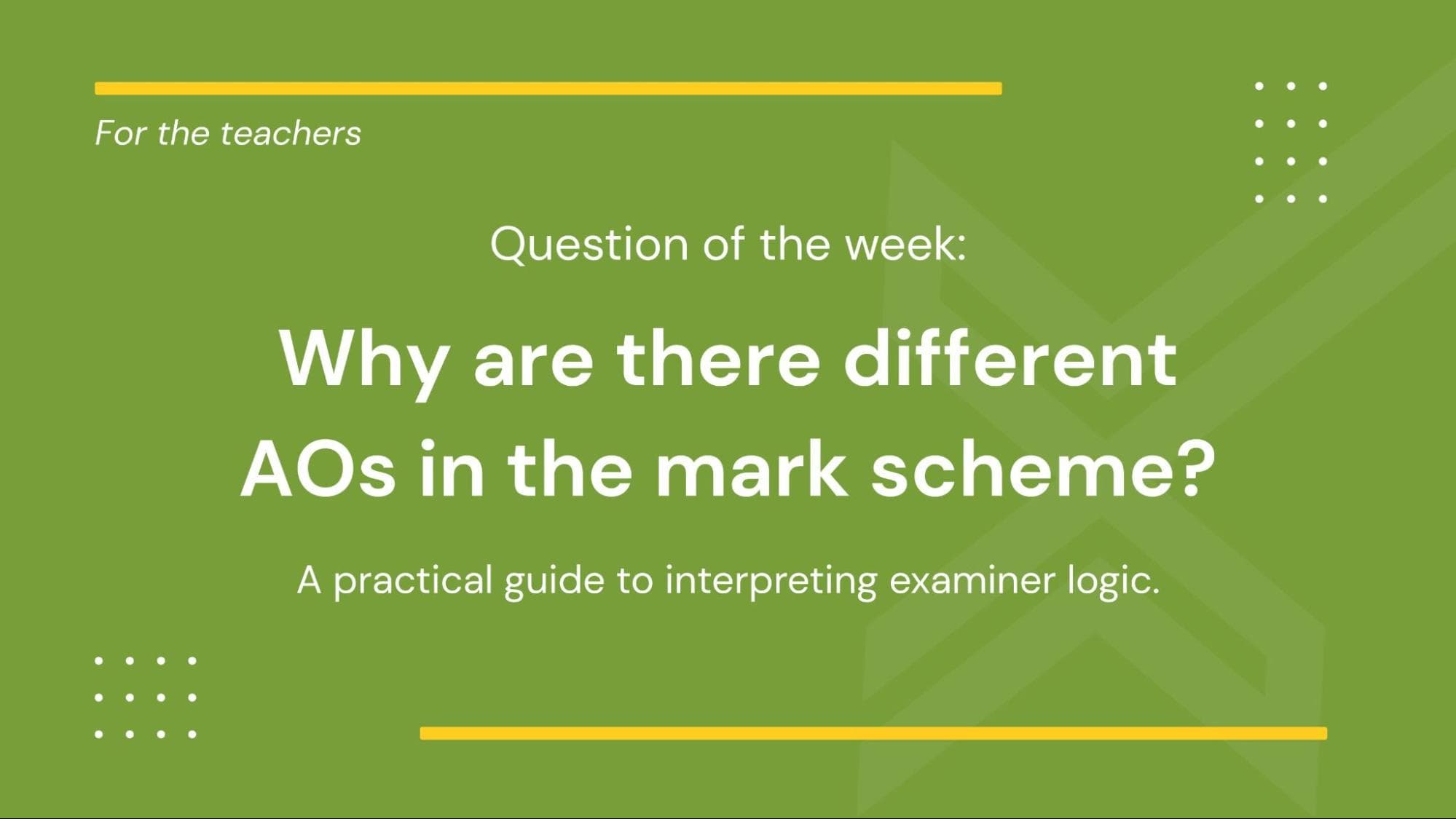Decoding the Mark Scheme: What are AO1, AO2, and AO3 in Science?
For a Science teacher, the mark scheme is more than just an answer key; it’s a complex matrix of cognitive skills and rigid procedural rules. While Maths teachers wrestle with M1 and A1 codes, Science teachers face a different beast: the Assessment Objectives (AOs) and the notorious "Level of Response" grids.
AO1, AO2, and AO3 aren't just labels; they define the difference between a student who has memorised a revision guide and one who can think like a scientist. But beyond the broad categories, there are hidden traps in the fine print such as rules about "lists," "phonetic spelling," and "best fit" that cause endless arguments in moderation meetings.
Let's decode the marking language of GCSE Science and explore the nuanced thinking that goes into every mark.
The 'What': Defining the Hierarchy of Scientific Skills
In Science, marks are awarded for the level of thinking demonstrated.
AO1: Demonstrate Knowledge and Understanding (The 'Facts')
This is the bedrock. AO1 marks are for recall.
- The Vibe: "Tell me what you know."
- Example: "State the equation for kinetic energy" or "Define the term 'isotope'." If the student remembers the fact, they get the mark.
AO2: Application of Knowledge (The 'Context')
This is where it gets trickier. AO2 is about taking those facts and applying them to a specific, often novel, context.
- The Vibe: "Use what you know to explain this specific situation."
- Example: The student knows how insulation works (AO1). An AO2 question asks them to explain why a specific type of double-glazing reduces heat loss in a house.
AO3: Analyse and Evaluate (The 'Scientist')
This is the highest level of skill. It involves analysing data, evaluating methods, or drawing conclusions.
- The Vibe: "Look at this data/experiment. What does it mean? Is it flawed?"
- Example: Critiquing an experimental method because variables weren't controlled or interpreting a complex graph.
...And What About the 'B1' Mark?
Just like in Maths, Science mark schemes use Independent Marks. These are standalone points awarded for specific correct details.
- Example: Correctly stating the unit (e.g., ℃) or labelling a specific part of a cell diagram.

Mark Scheme Guide for Science
Want to master the full language of the mark scheme?
Download your free Science marking glossary here.
The 'Insider' Rules: Where Students Lose Marks Unfairly
It’s not just about the AOs. The real headaches come from the specific procedural rules found in the examiner's front sheet.
1. The "List Principle" (Right + Wrong = Wrong)
This is a classic trap. If a question asks for two magnetic materials and a student writes "Iron, Steel, Tin," a human marker skimming the paper might award full marks for the first two.
The Rule: A wrong answer negates a right answer.
- Iron (Correct) + Steel (Correct) = 2 Marks.
- ...But adding "Tin" (Incorrect) cancels out one mark.
- Final Score: 1 Mark.
2. The "Phonetic Spelling" Trap
Science marking is surprisingly generous with spelling, but there is a catch.
The Rule: Marks are awarded if the spelling is phonetically correct, unless it creates confusion with another technical term.
- "Fotosinthesis" = Allowed (Intention is clear).
- "Meiosis" instead of "Mitosis" = Zero Marks (Technical confusion).
3. The "Best Fit" Ladder (Level of Response)
For those dreaded 6-mark extended answers, you don't just count points.
The Rule: You must start at the lowest level and use a "ladder" approach. You determine the level first based on the overall quality, then fine-tune the mark. Crucially, you must not penalise small errors if the overall answer meets the level descriptor.
The Traditional Fix: The Moderation Marathon
To enforce these rules, science departments hold moderation meetings. Teachers argue over whether a student's list of "Iron, Steel, Tin" should get 1 or 2 marks, or whether an answer is a "Level 2" or "Level 3."
It’s a vital process, but it’s flawed.
- Decision Fatigue: A teacher marking their 60th paper at midnight is likely to miss the "List Principle" and just tick the correct words.
- Inconsistency: One teacher might accept "Meiosis" as a spelling error; another will mark it wrong.
The AI Solution: Context-Aware Consistency
This is where AI assessment changes the game. An AI marking platform doesn't just scan for keywords; it applies the rigid logic of the mark scheme with zero fatigue.
- It Enforces the "List Principle": The AI automatically calculates "Right + Wrong = Wrong." It never accidentally ignores an incorrect addition to a list.
- It Masters "Best Fit": The AI evaluates extended writing against the Level descriptors instantly, applying the "ladder" method perfectly every time.
- It Understands "EcF" (Error Carried Forward): Just like a senior examiner, the AI knows that while a correct answer usually gets full marks, a correct answer derived from incorrect working must be awarded zero. It tracks the method, not just the final number.
The AO system is the gold standard for assessing scientific skill. AI ensures that this sophisticated system and all its complex procedural rules is applied with the consistency and fairness that your students deserve.
Now that you've decoded the mark scheme, the real work begins: getting students to engage with your comments. Is there anything more frustrating than seeing a student look only at the score?
If that sounds familiar, we've got you covered with some practical solutions to get students engaging with your comments.
